| 1768
October 1 British troops arrived in Boston to quell the growing unrest in the American colonies. |
| 1774
May 13 General Thomas Gage replaced Hutchinson as Governor of Boston. June 2 Parliament passed the Quartering Act, requiring American colonists to provide shelter to British troops and horses when requested. September 5 - October 25 Twelve colonies, all but Georgia, sent 56 delegates to Philadelphia to participate in the First Continental Congress. The purpose of the First Continental Congress was to debate and plan a unified response to British policy and actions. It was the first time many of these influential men had met face to face. September General Gage, the Governor of Boston, responded to increased threats of violence from the American colonists by fortifying Boston Neck, the thin spit of land connecting Boston to the mainland. This move effectively cut the city of Boston off from the rest of Massachusetts, placing the city under siege. October General Gage dissolved the Massachusetts General Court in attempt to thwart colonial power over Massachusetts. Members of the court reconvened as the Massachusetts Provincial Congress and voted to recruit 12,000 men for a militia (composed of American minutemen -- colonists prepared to fight the British on a minute's notice) and purchase 5,000 muskets and bayonets. |
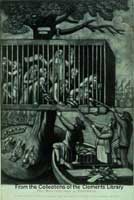
The Bostonians in Distress November 1774 |
| 1775
March 25 Patrick Henry delivered his "give me liberty or give me death" speech to the Virginia Assembly in Richmond. March 30 - April 5 General Gage ordered his troops on a practice march around Boston. The Massachusetts Provincial Congress at Concord viewed the British march as an act of open hostility. They issued formal grievances against the British government and adopted fifty-three articles of war against the British army. April 18 General Gage planned a secret night march on Concord to seize the colonists' store of weapons. Paul Revere immediately rode out over Boston Neck towards Lexington to warn John Hancock and Samuel Adams, fellow members of the Sons of Liberty. After Revere reached Lexington, he went to Concord where he was caught and questioned by six British officers. The officers left Revere horseless and stranded near Lexington. April 19 In Lexington, 130 minuteman, warned by Paul Revere, met the British troops in attempt to stop the army from reaching Concord. The American patriots were outnumbered and began to disperse. However, a shot was fired and the British troops killed eight colonists and wounded ten. The British troops continued for Concord where they were met by 150 minuteman. The fighting was light and plagued by the lack of discipline of the patriot minuteman. The British troops withdrew back to Boston after a mostly ineffectual search for hidden patriot weapons. The patriot minuteman raced ahead of the British army, hiding behind trees, rocks, houses and barns alongside the roads. The British army made an easy target for patriot snipers as they marched in straight lines in their red uniforms. The British troops returned to the safety of the Bunker and Breed's hills outside Charlestown, protected by the gunner ships lying in the Charles River. April April 23 The Massachusetts Provincial Congress called up 30,000 new militiamen and contacted other New England colonies requesting their help in raising the necessary troops to fight the British. May 6 May 10 Benedict Arnold and Ethan Allen raised a troop of 83 men and storm Fort Ticonderoga, capturing 50 officers and 100 cannons. The Second Continental Congress convened in Philadelphia. All thirteen colonies were represented. June 15 George Washington was named Commander-in- Chief of all the American troops by the Continental Congress. June 17 American militiamen approached Bunker Hill at night to build fortifications by digging trenches and raising walls. The British tried unsuccessfully to stop the colonists from their ships in the Charles River. British troops were also sent in formation to attack the militiamen. They are repelled twice by the colonists, suffering heavy causalities. By the third attempt, the American militia had run out of ammunition and were killed or captured. The British won the battle, but at a heavy cost, raising the hopes of the American colonists. |
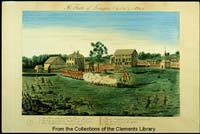
The Battle of Lexington
|
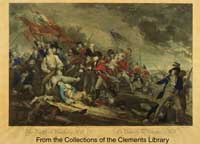
Battle of Bunker Hill 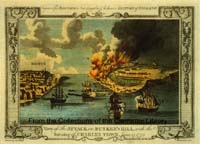
Battle of Bunker Hill |
| 1776
February 27 The patriots defeated the Loyalists at Moore's Creek Bridge. March 7 The British evacuated Boston after 2000 men, led by John Thomas and aided by heavy cannonade, occupied the city during the night of March 4-5. March - May France and Spain arranged to secretly provide support to Britain's rebellious colonists through fictitious companies. June 11 Congress appointed a committee to produce a declaration of independence. Within the committee, consisting of Thomas Jefferson, Benjamin Franklin, John Adams, Robert R. Livingston, and Roger Sherman, Jefferson was appointed to prepare a draft of the declaration. Jefferson's draft, with minor changes suggested by committee members, was debated in Congress on July 2 and July 3. July 4 The amended Declaration of Independence was approved without dissent. The declaration was first publicly proclaimed on July 8 in Philadelphia, and was read before George Washington and his troops on July 9 in New York City. August 27 After William Howe evacuated Boston, he decided New York City should be his base of operations. On August 27, Howe and his 20,000 forces defeated the patriots on Long Island. September 11 William Howe and his brother Richard Howe met with Congressional representatives at Staten Island. They were appointed peace commissioners by the king, but were instructed not to negotiate unless all extralegal congresses and conventions were dissolved. The meeting was fruitless. September 15 The British occupied New York City. September 22 American spy Nathan Hale was executed in New York City. December 26 George Washington mounted a surprise attack on Hessian troops at Trenton by crossing the icy Delaware. He returned to Pennsylvania with his prisoners, crossed the river a third time, and reoccupied Trenton on December 30. |
Declaration
of Independence |
| 1777
January 3 William Howe sent troops toward Trenton and Princeton after he heard about the Trenton defeat. George Washington's troops, however, gained a victory at Princeton. July 17 July 23 William Howe embarked from New York with 15,000 troops, sailed up Chesapeake Bay, and landed at the Head of Elk on August 23. In the meantime, George Washington and his 10,500 men chose a defensive position on the eastern side of Brandywine Creek. August 10 September 11William Howe defeated the American troops, under George Washington, at the Battle of Brandywine. The American army was forced toward Philadelphia. September 26 William Howe and his troops occupied Philadelphia. Congress left Philadelphia on September 19 for Lancaster, and fled to York on September 30. October 4 George Washington began a movement toward William Howe's main encampment at Germantown. Losses were heavy on both sides. October 7 The patriots won the Second Battle of Freeman's Farm against Burgoyne. Burgoyne retreated toward Saratoga, where he eventually surrendered. On October 17, Burgoyne's army laid down their arms according to the terms of the Saratoga Convention. December 19 George Washington's army retired to winter quarters at Valley Forge. |
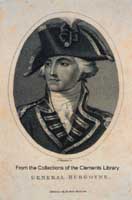 |
| 1778
February 6 The United States and France signed an alliance. The treaty included 1) most favored nation status and 2) an alliance in case of war between France and Britain. April 12 The Earl of Carlisle led a commission to make peace with the United States. On February 17, Lord North proposed in the British Commons to repeal the Tea and Coercive Acts, impose no new taxes on the colonies, and create a peace commission to prevent the United States from ratifying a treaty with the French. When the Earl of Carlisle arrived in Philadelphia, he learned that Congress considered anyone an enemy who made peace with the commission. The commissioners moved to New York after the British evacuated Philadelphia and returned to England on November 27. May 8 Sir Henry Clinton replaced William Howe as Commander-in-Chief of the British forces in America. June 18 The British evacuated Philadelphia and moved across New Jersey towards New York, because Clinton was concerned about the arrival of French fleets. George Washington pursued Clinton's troops as they left Philadelphia. After nearly failing, Washington stopped Clinton's attack at the Battle of Monmouth. Washington then led his troops north. On July 30, he set up camp at White Plains, above New York City and Clinton's new headquarters. August July 29 - August 29 French and American troops mounted a joint operation against the British garrison in Newport, Rhode Island. August 31 American troops, under the leadership of General John Sullivan, and the French troops, led by the Marquis de Lafayette, withdrew as Clinton sent a great number of men and ships to Rhode Island. December 29 Sir Henry Clinton decided to attack the South, because he thought he could gain more loyalist support there. General Robert Howe landed near Savannah, Georgia and captured the town. |

Sir Henry Clinton |
| 1779
January 6 - June 19 The British made progress in the South against the Americans. On March 3, the British were victorious at Briar Creek, Virginia. On May 10, the British captured and set fire to Portsmouth and Norfolk, Virginia. May 10 May 31 - September 15 The British made progress in the North against the Americans, but the Americans also won some battles. In May, Sir Henry Clinton led 6,000 men up the Hudson River and seized American forts at Stony Point and Verplanek's Point. The British also preyed on the coast of Connecticut. However on July 15, American forces recaptured Stony Point. Patriot forces also defeated bands of loyalists and Native Americans who were attacking settlements in New York and Pennsylvania. June 21 Spain entered the war against Great Britain. Although Spain initially opposed American independence, when the British refused to cede Gibraltar to Spain, Spain sealed an agreement with France to enter the war. June 27 August 14 Congress proposed terms of peace with the British, including independence and British evacuation of American territories. After long debate about the terms, Congress named John Adams negotiator on September 27. September 3 - October 28 A French fleet and American troops unsuccessfully tried to capture Savannah, Georgia. October 11-25 The British abandoned Rhode Island. |
|
| 1780
February 11 - May 12 Sir Henry Clinton attacked Charleston, South Carolina. After defeating patriots heavily, Clinton left for New York on June 5 and placed the British General Charles Cornwallis in charge on the area. Patriots continued to stage resistance. July 11 Comte de Rochambeau landed in Newport, Rhode Island with a strong naval fleet and 5,000 French troops to assist the patriots' cause. George Washington planned to combine his army with Rochambeau's and attack Sir Henry Clinton in New York, but the attack never materialized. July 12 July 15 September 21 Benedict Arnold met with John André on the west bank of the Hudson River to inform the British about the weak points of West Point. September 23 Three American militiamen apprehended John André as he was returning from a secret meeting with Benedict Arnold. Benedict Arnold's plot to sell West Point was uncovered. Benedict Arnold fled to safety in New York City. September 29 October 2 John André was hanged as a British spy. |

|
| 1781
January 1 The Pennsylvania Line mutinied. Half of the patriot veterans grew angry when recruiters offered money to new enlistees. The veterans seized their arms, wounded officers, and quit their camp. On January 20, the New Jersey Line mutinied. March 1 The Articles of the Confederation were ratified. Although proposed on November 17, 1777, Maryland had refused to ratify it. The Articles of Confederation provided for a Congress like the one in existence at the time. Each state had one vote, with delegates appointed by the state legislature. Congress could pass resolutions and enact ordinances, but it did not have any courts to enforce its orders, nor did it have a stable executive department. May 21 George Washington and Comte de Rochambeau agreed to attack New York jointly with the support of Comte de Grasse's French West Indian fleet. May 29 August 14 Washington received a letter from Comte de Grasse that he would leave the West Indies on August 13 to join American troops in Chesapeake Bay. Washington decided to abandon the attack on New York and prepared to march to Virginia instead. August 15 August 30 - October 19 The Yorktown Campaign. On August 30, Comte de Grasse had set up a naval blockade around Yorktown. By joining forces with Lafayette, he trapped the British General Cornwallis on land. De Grasse sent ships to pick up Washington's and Rochambeau's troops in Chesapeake Bay. With 9,000 American and 7,800 French troops, the allied army seized Cornwallis at Yorktown between September 14 and 24. On September 30, Cornwallis abandoned the outer line of fortifications. After a desperate attempt to escape across the York River, Cornwallis opened up negotiations on October 17. Afterwards, Washington wanted to go back and capture New York, but de Grasse went back to the West Indies with his fleet. |
American General and Rifle-man |
| 1782
March 20 Lord Rockingham replaced Lord North as prime minister of Great Britain and began peace negotiations with America. As a result of Cornwallis' army being captured by American forces and the French defeating the British in the West Indies in 1781 and 1782, Great Britain's desire for peace was augmented. April 4 Sir Guy Carleton arrived in America to succeed Sir Henry Clinton as British commander. As peace negotiations began Carleton moved all of the British forces toward the shores of New York, to ready for departure. September 27 Formal negotiations of peace began in Paris, France. Benjamin Franklin, John Jay, and John Adams negotiated for the Americans, and Richard Oswald, a wealthy merchant, represented the British. November 30 Americans and British sign a preliminary peace treaty in Paris. The American negotiators disobey Congress's instructions to consult with the French about the treaty because of fears that France's support of Spain would cause great restrictions to America's territorial borders . |
Letters | Stories | Methods | People | Routes | Timeline | Home
Clements Library | Sir Henry Clinton Collection | Teachers' Lounge | About the Project | Bibliography